|
Pictures from 2010 |
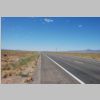 |
We entered Arizona from Nevada via the Hoover Dam. After
a lunch in the town of Kingman, we started out on America's most famous
road (I think), Route 66 Here we are just outside of Kingman, which can
still be seen in the distance. |
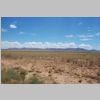 |
In the opposite direction you can see the mountains (the
Grand Wash Cliffs) in the distance. |
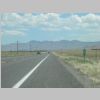 |
Closer to
the mountains, the traffic got heavy :-) At the side of the road
Burma Shave signs, |
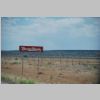 |
Another
Burma Shave sign. |
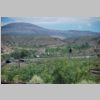 |
The
railway runs close to the road at this part of Route 66. |
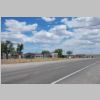 |
Not all
the service stations along Route 66 have been shined up. |
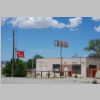 |
Some are
worn down and others are closed. |
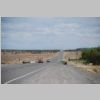 |
Entering
the Hualapai reservation. |
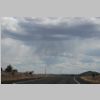 |
In spite
of heavy clouds, we saw no rain - yet. |
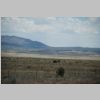 |
But a lot
of dust devils. |
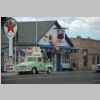 |
Seligman
has preserved the style of Route 66's heyday in the fifthies. This is
Angel and Vilma's Gift Shop. |
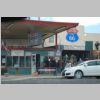 |
And J & R's
Minimart and Deli! |
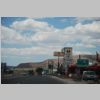 |
Leaving
town we passed Roadkill Cafe, offering buffalo burgers. We tried buffalo
burgers, but not until we got to Wyoming. |
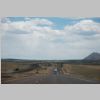 |
Going east
on Interstate Highway 40. |
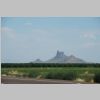 |
And
heading south on I-17 after a long stretch on U.S. Route 89. |
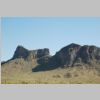 |
And
entering cacti country. |
 |
To be sure
to see some big cacti, we visited Saguaro National Park. |
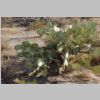 |
On our way
to the park's visitor center we saw several species of cacti. |
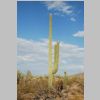 |
The park's
name origins from the big saguaro cactus. A proctected species. |
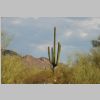 |
These
cacti starts as a single stem and only when they are between 50 and 75
years old, branches appears. |
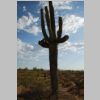 |
The
saguaro can
get more than 30 feet tall and live for about 150 years. The largest
known saguaro is almost 45 feet and 30 feet around. |
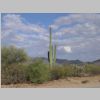 |
I don't
know how tall this was, but it was tall. |
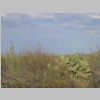 |
Of course
the saguaroa are most impressive, but there are many other nice cacti in
the park. |
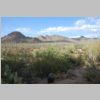 |
But once
again the saguarosa dominate the landscape. |
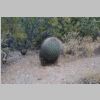 |
Here is
another type. I don't know the name or the species of this one, but then
I'm not a cacti expert. |
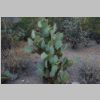 |
This one I
do know though. It's called a Prickly Pear. |
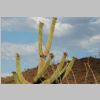 |
The
saguaros are blooming between April and June, so that had passed when we
visited but we saw their big red fruits.
|
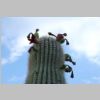 |
Close up of the fruits. They are edible and the locals loves them. |
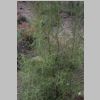 |
Another
unknown (at least to me) cactus. |
 |
Tim next
to a saguaro. He is 6'5" (without the hat) and that gives an impression
of the size of the catus. |
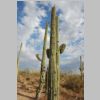 |
When the
cacti get older, they dry up from the inside. This is used by birds,
that nest in the hollow cacti |
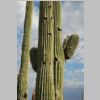 |
A bird
entered one of the holes just before I took this picture, but it
refused to leave, while we were waiting, so no bird this time. |
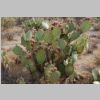 |
Another prickly pear. |
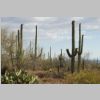 |
And the
final picture from Saguro National Park. But don't you worry; more cacti
will appear later. |
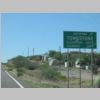 |
Next stop
in southern Arizona was Tombstone. |
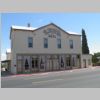 |
This is Schieffelin Hall in Tombstone. The house was
built in 1881 by Al Schieffelin, brother of Tombstone's founder, Ed
Schieffelin. The South West's then largest adobe building served
as an opera house. The opera house had room for 600 spectators. On 18th
of March 1882 brothers Wyatt and Morgan Earp were among the
audience just before Morgan Earp was shot in revenge for the OK Corral
shoot out. |
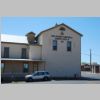 |
Today the
building houses King Solomon Masonic Lodge #5, one of the five original
masonic lodges in Arizona. |
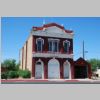 |
Close by
you find the old town hall. |
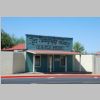 |
And on the
opposite side of Fremont Street you find Camillus Fly's Photography
Gallery. |
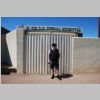 |
Next door
to Fly is the O.K. Corral. Actually the original O.K. Corral was
further down the street. Next to Fly's shop was an empty lot, and it was
in this lot that the most famous shootout of the old west took place. |
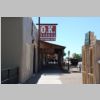 |
Today you
have to pay and admission fee to enter. It was only 10 AM and we didn't
want to wait to see a reenactment of the shootout at two PM, so we just
took a walk. |
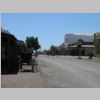 |
Mainstreet
in historic Tombstone. |
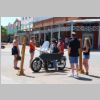 |
On
mainstreet we met this guy driving around with a parrot on his
motorcycle. Some spectators had their picture taken with the bird like
the girl in the red blouse and denim shorts. As Tim suffers from
ornithophobia to some degree, we just took some photos of other people
with the bird. |
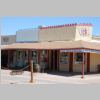 |
The
historic district in Tombsatone is still a western town with false
facades and elevated sidewalks. |
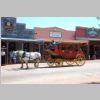 |
The town
is extremely "touristy". |
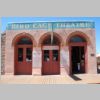 |
The old
theatre |
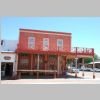 |
And a
brewery |
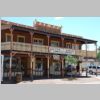 |
And quite
a number of saloons. |
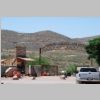 |
And a
mine. The guy at the entrance, was very eager to sells us tickets for a
visit to the mine. |
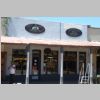 |
There is
also a General Store in town. |
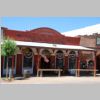 |
And Big Nose Kate's
Saloon. Big Nose Kate was Doc Holiday's girlfriend and she actually
didn't own a saloon ran a boarding house. |
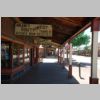 |
A last
glimpse of the sidewalks. |
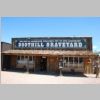 |
Then we
drove to the famous Boot Hill Graveyard. |
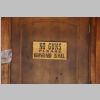 |
A very
good advice. |
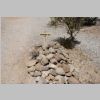 |
The
graveyard is known for its headstones, made of wood. Some with shorter or
longer inscriptions. Her is the grave of Dutch Annie, who died in 1883. |
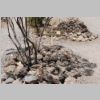 |
And Ben Olleny,
was killed by Chinoon. |
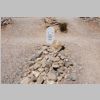 |
Tom Waters,
shot in 1880. |
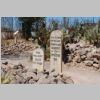 |
And a
memorial for the three that was killed in the OK Corral shootout, Tom and Frank McLaury
and Bill Clanton. |
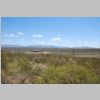 |
Before
continuing the tour around the graveyard, we enjoyed the view of the
surrounding landscape. |
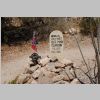 |
The grave
of Newman Haynes Clanton, called "Old Man". He was the father
of four sons, among which
Billy og Ike took part in the O.K. Corral shootout. Ike was later killed
in a duel and daddy was killed by mexicans, probaly as revenge for a
duel in connection with cattle rustling. |
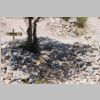 |
Not
everybody died from bullet wounds. Dan Dowd was hung. |
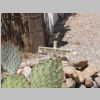 |
And "Three-finger Jack"
was killed by Jeff Milton. |
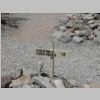 |
How Christina B.
Christiansen died is not mentioned, but her name sounds Danish. |
 |
Some of
the buried are unknwon today like these two chinese. |
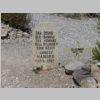 |
And here
is a group that was hung together - legally. That was in March 1884.
Maybe the hanging is related to the event mentioned below. |
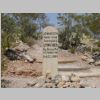 |
John Heath
was removed from jail and lynched in February of the same year. Maybe
this lynching was the reason for the hangings, two weeks later. |
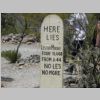 |
Some inscriptions are
quite poetic, like this about Lester Moore, who was killed by four slugs
from a 44. It is often shown as example of Boot Hill inscriptions.
|
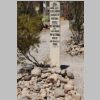 |
I like
this more though from the grave of George Johnson, hanged by mistake: "He was
right and we was wrong, but we strung him up, and now he's gone."
|
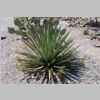 |
Boot Hill
Graveyard also has a lot of plants. |
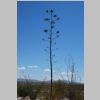 |
Like this
agave. |
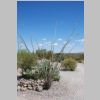 |
And
another species of cactus. |
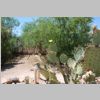 |
And a
blooming cactus too. |
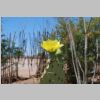 |
A little
closer. |
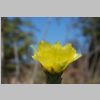 |
And very
close. To get this picture I got too close to the cactus, and it took me
several days to before I had removed all the thorns. |
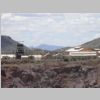 |
The next
town we passed was Bisbee. This is an old copper mine town, and you can
still see the one of the mines. |
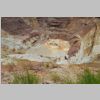 |
The bottom
of the mine. |
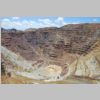 |
And the
terraces, where the copper was mined. |
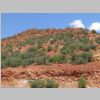 |
From Bisbee
we continued south through interesting landscapes. |
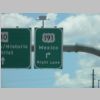 |
Heading to
the Mexican border. |
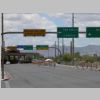 |
Which we
reached in Douglas. We didn't cross the border, but this was the
southernmost point of this years vacation. |
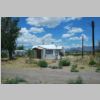 |
The town
of Elfrida. Obviously a poorer part of USA. |
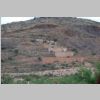 |
In these
mountains Apache chief Cochise had his stronghold. |
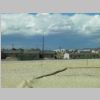 |
And here
we are driving through the San
Carlos Apache Indian Reservation; the poorest indian reservation in the
United States. |
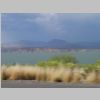 |
Heading
towards central Arizona, we passed Roosevelt Lake. |
 |
The lake
was created by damming the Salt River and the Tonto River. |
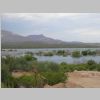 |
In the
northen end of the lake, it was very visible, that the water was high. |
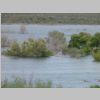 |
A lot of
land had been flooded. |
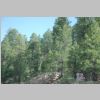 |
Next day,
we drove west on small roads to the town of Camp Verde. |
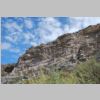 |
Stille
heading for Camp Verde. |
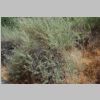 |
Our goal was Montezuma
Castle National Monument, and the first thing we saw was this saltbush. |
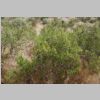 |
And a creosote
bush. This is a strongly scented shrub, that in Spanish are called "the
little stinker! |
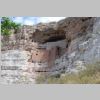 |
The "castle"
itself. Build around 1125 by the Sinagua people and deserted again
around 1425. Around 50 people have lived in the building, that have five
floors and 20 rooms. |
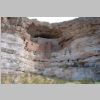 |
The first
white visitors thought the place was build by the Aztecs and named it
for Aztec emperor Montezuma (actually Moctezuma). |
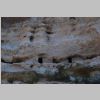 |
There have
also been found remains of a larger building complex, but this has not
survived in its entirety. |
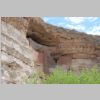 |
The
castle from another angle. |
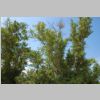 |
The area
has a lot of flowers, shrubs and trees. Here a dogwood. |
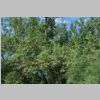 |
And this
is an acacia. If anybody thinks I suddenly turned into a botanist, they are wrong. Most trees and bushes was marked with signs. |
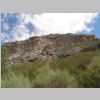 |
The castle
has not been easy to gain access to. |
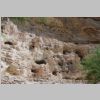 |
The many
caves in the mountain side was used for storing food and other
necessities. |
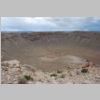 |
Except for
a short stop in Flagstaff we continued to Arizona's famous meteor crater. 50.000
years ago the earth was hit by a meteor with a diameter of around 150
feet and a weight of 300,000 ton. The speed at impact was around 30,000
miles per hour. |
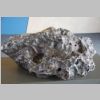 |
The meteor
almost vaporized and this is the largest piece found. It meassures
around 15 times 12 inches. |
 |
Tim at the
edge of the crater that has eroded a lot in the last 50,000 years. It is
almost 4,000 feet across and 550 feet deep. It is
surrounded by a 150 feet high rim. The center of the crater is filled with
a layer of gravel, almost 800 feet thick. |
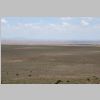 |
The
surroundings are flat for miles. |
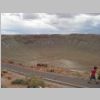 |
In earlier
days it was supposed that the complete meteor was buried somewhere
below the surface and a lot of digging took place. Remains of the digging equipment is still at the bottom of the
crater. |
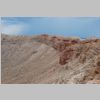 |
Part of
the rim. |
 |
And the
road across the plain. |
 |
At the crater you find a small museum that mostly has exhibitions connected to
meteors and other similar phenomenons, but it alså shows some fossils,
found in the aera like this Placerius Hesternus, a
lizard
with mammal-like
features, which
lived from
plant foods.
9 feet
in length and
weighing
2
tons, you wouldn't want him to step on your toes. |
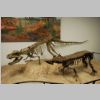 |
The animal
at the back is a Postosuchus Kirkpatricki, a relative to modern day
crocodiles. Being about 15 vfeet in lenght it walked more upright than a
crocodile. The animal in front is a Desmatosuchus Haplocerus, another
crocdile relative, but unlike it's present relatives, it was a
herbivore. |
 |
After the
visit at the crater, we drove further east, almost to the New Mexican border, for a
visit to Petrified Forest National Park. |
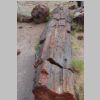 |
In the
southern part of the park, you find the majority of petrified wood, some
almost as whole trees others in bits and pieces. |
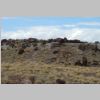 |
These
trees didn't grow in the area but was flushed here by rivers and floods
around 200 million years ago. |
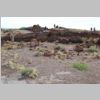 |
Later they
were buried in volcanic ashes, containing silicats, that entered the
wood and turned into the quartz that makes the petrified trees. |
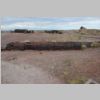 |
The layers
that covered the trees eroded, and the trees were left as we see them
today. |
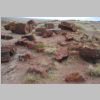 |
The
different colors are due to the quartz contaning minerals like iron. |
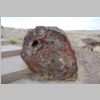 |
The
quarts is really visible here. |
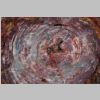 |
And as
shown here, even the tree's growth rings are visible in chrystalized
wood. |
 |
As seen
from the person in the foreground, some of the trees were really big.
Most of them belonged to the species Araucarioxylon arizonicum, that
could grow to almost 200 feet. Nine species of tress, now all extinct
have been found in the park. |
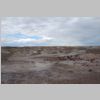 |
The trees
are spread over a large area. |
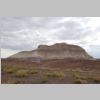 |
Besides
from trees, also rock fomations are found in the National Park. |
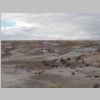 |
But trees
are the majority. |
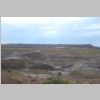 |
Trees -
and rock formations. |
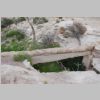 |
This tree
that crosses the ravine is called Agate Bridge. In 1917 the "bridge" was
supported by a concrete span. Today no such thing would be done. Nature
would take it's course, the tree would be left to disintegrate and finally
fall into the ravine. The same thing will of course still happen, as
the concrete span is no longer maintained, but it will take a bit
longer. |
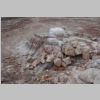 |
Another
rock formation. |
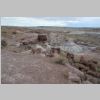 |
Even more
rock. |
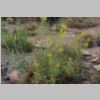 |
Even
though the national park is in a desert area on top of the Colorado
Plateau, there is a lot of plants here. |
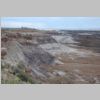 |
As you get
further north the petrified trees get sparse, and the multicolored
cliffs become the main attractions. |
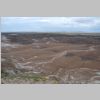 |
Here you
see the driedup rivers, that leads the water over the plains, in rainy
periods. |
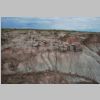 |
And the
water has even eroded the rock. |
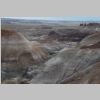 |
A riverbed
and striped rocks. |
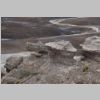 |
A
turtle-like rock and another riverbed. |
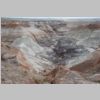 |
Another
riverbed in the Painted Desert in the northern part of the NP. |
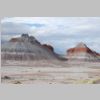 |
Painted Desert
beginds around the small town of Cameron at Route 89 and stretches
southwest to the border to New Mexico. |
 |
More
colored rocks. |
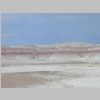 |
And even
more. |
 |
The park
also contains many traces of former human habitation. The photo shows
the so-called Newspaper Rock with many petroglyphs. |
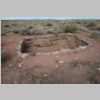 |
And one of
the old ruins. |
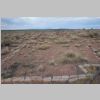 |
The ruins
of a larger settlement. |
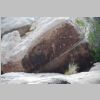 |
And more
petroglyphs near the ruins. |
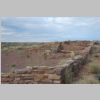 |
Actually
there are more than 600 archeological sites within the park. The
oldest traces of human activites goes back 8.000 years, but most ruins
are from the "ancestral puebloes" period from 900 to 1250 AD. |
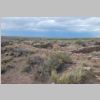 |
The Puerca
Pueblo, with around 100 rooms are centered around and open square. There
were no doors and windows in the houses. To enter you used a ladder to
climb to the roof and through a hole, down to the living quarters. |
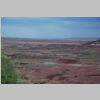 |
It is now
getting darker, and when the lights changes, so does the colors of the
Painted Desert. |
 |
Another
picture of a park landscape. |
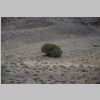 |
And a
lonesone bush in the middle of the desert. |
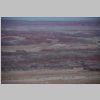 |
A final
glimpse of the multicolored desert. |
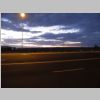 |
And the
sun set over the desert. |
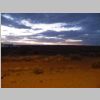 |
As seen from our hotel in Holbrook. |
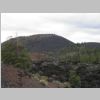 |
The next
day we visited Sunset Crater National Monument north of Flagstaff. The
volvano has it's name from the red colors on the top of the cone,
that looks even more red at sunset. |
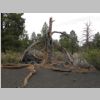 |
Around the
crater you find a lot to look at, like this dead tree. |
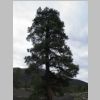 |
Or this
Ponderosa pine. |
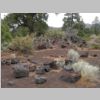 |
And also a
number of other bushes are growing in the Volcanic sand. |
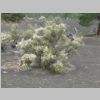 |
Like this
Apache Plume, the most common bush in the area. |
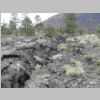 |
Also a lot
of traces of the volcanic activity like this lava flow. |
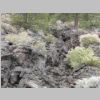 |
And more
here. |
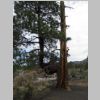 |
Some
trees have grown into intersting shapes. |
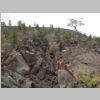 |
Another
crack in the lava. |
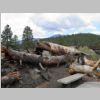 |
And a
couple of fallen trees. |
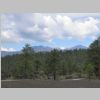 |
View over San Francisco Peaks,
the remains of an exstinct volcano. |
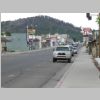 |
A little
further west on the I-40, we visited Williams. |
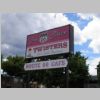 |
Here we
visited The Twister Cafe, still kept in the style of the fifties.
|
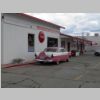 |
Outside
the cafe, you can look at this pink and white wonder. |
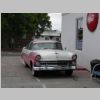 |
Some
tourist guides tells about the pink Cadillac, but the car is actually a Ford Fairlane Crown Victoria from
1955 or 1956. |
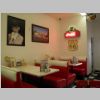 |
The foot
was good and the interior was kept in style. |
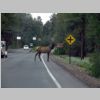 |
We have
just entered Grand Canyon National Park, and were met by this elk,
playing road block. |
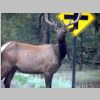 |
Elks are
not as big a moose, but still big enough to cause a lot of damage if you
hit them with your car. |
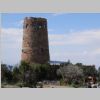 |
Tower at
Desert View viewpoint near the east entrance to the NP. |
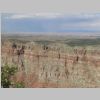 |
From Desert
View you have a great view of the canyon as well as the desert. |
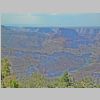 |
When we
got there, there was a lot of haze but in spite of that you get a good
impression of the Colorado River winding throug the canyon. |
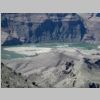 |
Another
overlook is at Lipan Point with an even better view of the river. |
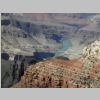 |
At Lipan Point
the canyon reaches it's largest depth. |
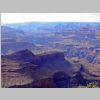 |
At Moran Point
overlook you can enjoy some of the many interesting rock formations,
that has been created by the erosion. |
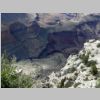 |
Even more
rock formations. |
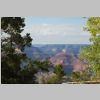 |
At Grand View Point,
there is a fantastic view of the canyon. |
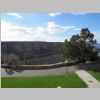 |
We got our room at Katchina Lodge
and enjoyed the view from our window. |
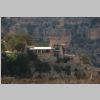 |
And when
we looked in the opposite direction, we could see the old photographic
studio, Lookout Studio,
now used for exhibitions. |
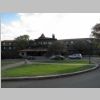 |
El Tovar Hotel from 1905
was the first hotel built in Grand
Canyon Village. |
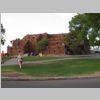 |
Opposite El Tovar
is Hopi House, also from 1905 but built in old Hopi style. |
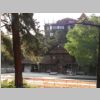 |
And the
northern terminus of the Grand Canyon Railway. |
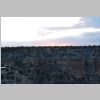 |
In the
late afternoon we returned to the room. |
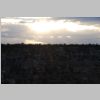 |
Even later
and the sun began to set. |
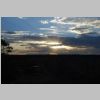 |
Unfortunately sunset was almost hidden behind the clouds. |
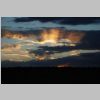 |
But the
clouds created this gloomy look. I almost expect to see the four riders
of the apocalypse coming out of the sky. |
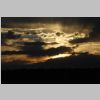 |
And then
the sun set. |
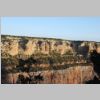 |
The next
day we got up early, so no haze had appeared yet. This was around 6AM. |
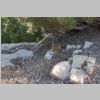 |
A couple
of rock squirrels. |
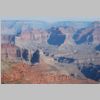 |
At Hermit's Point
at the western end of South Rim road. At 8 AM the haze had already
appeared. |
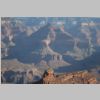 |
But we
could still enjoy the view |
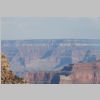 |
Notice the
layers of rock in the background. |
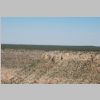 |
Also from
this spot, you have a good look to the almost flat plain on the
opposite side of the canyon. |
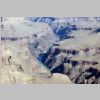 |
And a view
of the river. |
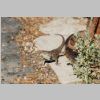 |
At Hermit's Point
we met this colorful representative of the animal life in the canyon
area. |
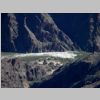 |
One of the
rapids of the Colorado River. |
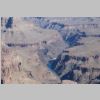 |
More
river. |
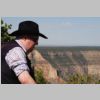 |
Tim enjoys
the view from Powell Point. |
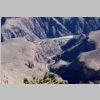 |
A dried-up
riverbed in a side canyon. |
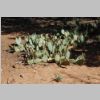 |
From Powell
Point we walked back to Grand Canyon Village and on our way we passed
these small cacti. |
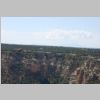 |
View of
the hotels in Grand Canyon Village. |
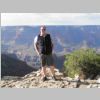 |
Walking
along Grand Canyon brings you close to the edge, so you got to take care
of yourself. It's only one step down - but a big one. |
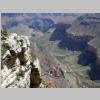 |
Bright Angel Trail -
one of the trails. leading to the bottom of the canyon. |
 |
Indian Garden,
is halfway down the trail. Here you can replenish your water holdings. |
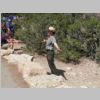 |
Finaslly a
picture of Ranger Maggie, busy explaining something about the canyon. |
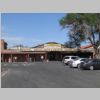 |
The
trading post in Cameron on the edge of the Navajo Nation. |
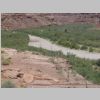 |
Little
Colorado River was completely dried up, when we passed it. |
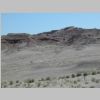 |
Entering
the northwestern part of Painted Desert. |
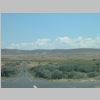 |
Heading
east through Navajo Nation. The moutains ahead is part of Black Mesa. |
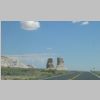 |
And yet
another picture from northeastern Arizona. |
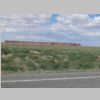 |
This is
the Red Mesa. |
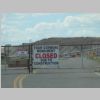 |
We wanted
to visit Four Corners Monument like in 2006, but unfortunately the
monument was closed. |
|
Pictures from 2006 |
 |
When driving south
from Hoover Dam, you find yourself in the southern Mojave Desert, which
also extends into the states of Nevada and California. |
 |
At Kingman you can
change to I-40, but you can also choose to drive a stretch of Route 66,
The Mother Road, Mainstreet of America, or whatever you like to call this cult road. The stretch between Kingman and Seligman is one of the
best preserved pieces of the old road. |
 |
The actual road really
looks like many other roads in the American southwest, but nevertheless
it is an experience to travel on a path that is known from both music and
literature, such as in Jonh Steinbeck's The Grapes of Wrath. |
 |
The road goes partly
through the Hualapai Reservation. When we got there the clouds began to
pull together and it was raining in the distance, but we never got more
than a few drops ourself. Actually, we didn't even have to use the
wipers. |
 |
We stayed in the town
of Williams, where Route 66 is still Main Street, something you are not
allowed to forget for even a minute. |
 |
Although the city
advertises that there are 30 miles to the nearest traffic light, the
vehicle here is not the preferred means of transportation in town. But
tourist can buy themselves a stage coach ride. |
 |
From Williams, we took
the Grand Canyon Railway to Grand Canyon Village, and before the train
left, we attended a "shoot out" in a western set up at the end of
the platform. |
 |
It was on
that occasion that I got the opportunity to photograph this impressive
butterfly, which had a 4" wingspan. Oculea Silk Moth is the name and it
may actually have a wingspan of up to 6". |
 |
En route to the Grand
Canyon the train goes through varied landscapes. Here we are crossing
the prairie, not far from Williams. |
 |
It is impossible to do
justice to the Grand Canyon in pictures. It must be experienced. When we
visited the place, there were some haze, that did not make it easier
catch the true erxpirience, but enjoy the following pictures anyway. |
 |
It is hard to describe
the pictures, so I think that I just let them speak for themselves. |
 |
|
 |
|
 |
|
 |
|
 |
|
 |
|
 |
|
 |
|
 |
|
 |
We walked up and down
a lot in the 2,100 meters altitude, so sometimes it was nice to have a
rest. Notice that there are no railings. It is people's own
responsibility, that they do not take the one step, 5,000 feet stairway
down to the bottom of the canyon. |
 |
Occasionally the path
was very close to the edge, but actually it is an amazing few who
actually fall down. Most who die in Grand Canyon, and it is some each
year, die from overwork because they underestimate how difficult it is
to get into, and especially up from the canyon, and thus overestimates
the their own physical condition. Most of those who die are young men
between 20 and 30, which are in good shape - just not good enough. |
 |
Although the canyon is
very beautiful, we nonetheless had time to enjoy other things as well
such as the varied vegetation. Here are some small cacti. |
 |
Along the canyon are
hotels and most of them have rooms right on the rim. |
 |
In this picture you
can see El Tovar Hotel, who was the first hotel built in Grand Canyon
Village way back in 1905. |
 |
Next to El Tovar is
Hopi House, and here happened to be an appearance of Navajo and Hopi
dancers, as we passed. The musician is playing for the dance, as a
female dancer is leaving the place. |
 |
North of the city of
Flagstaff you find Arizona's highest mountains, the San Francisco Peaks,
and not far away is the probably extinct volcano Sunset Crater. The
volcano does not look like much, but it is actually 2,451 meters above
sea level. When it does not appear larger, its due to the Colorado
Plateau it self being around 2,100 meters above sea level. The volcano last erupted in the 1300s. |
 |
Not far north of
Sunset Crater you enter the Navajo Reservation. In the town of Cameron
are several shops selling Native American crafts, and here we found this
beautiful pot. Unfortunately the price was a little to high at $ 1,300,
so we decided to leave it and settle for the picture. |
 |
This
bridge is on the outskirts of Cameron, and on the other side of the
bridge you enter the northwestern part of Painted Desert. |
 |
Painted Desert takes
its name from the many colors the rocks and desert sand has. Colors are
changing with the weather, and with the sun, so you can visit the same
place several times and each time see it as new. |
 |
Painted
Desert is in its own way just as impressive and just as beautiful as the
Grand Canyon, although this area seems much "softer". |
 |
Personally, I think that the Painted Desert made a bigger impression on
me than the Grand Canyon, mostly because Painted Desert was a surprise.
Grand Canyon, I've seen many times on film and in television, so here I
knew what I had in store. |














































































































































































































































